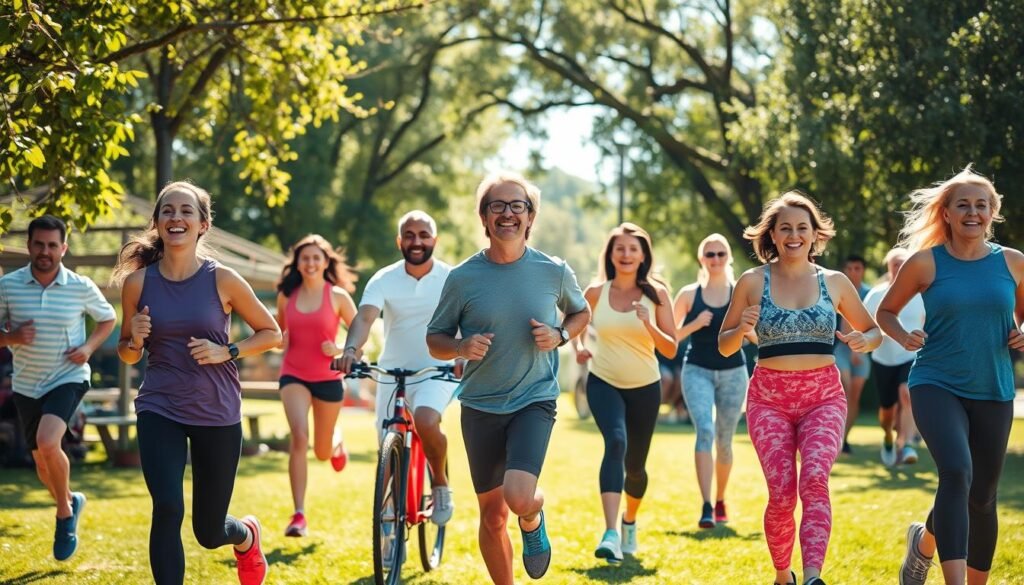Did you know that nearly one in five adults in the United States experiences anxiety each year? This fact highlights the need to take care of our mental health in today’s busy, tech-filled life. The age of anxiety brings many challenges, pushing people to find ways to manage their anxiety well.
This article aims to raise awareness about anxiety’s rise and offer tools for daily life. It covers everything from mindfulness to staying active to better handle anxiety. For more ways to deal with anxiety, readers can check out other methods mentioned in this article.
Key Takeaways
- Nearly one in five adults experiences anxiety disorders annually.
- Mindfulness meditation apps are increasingly popular in 2024.
- Regular physical activity can significantly reduce anxiety levels.
- Effective coping mechanisms include deep breathing exercises and CBT.
- A consistent sleep routine improves mental health and reduces stress.
- Social support plays a vital role in combating anxiety.
Understanding Anxiety Disorders
Anxiety disorders include a range of mental health issues marked by extreme fear or worry. Those facing an anxiety disorder often deal with ongoing unease. It’s critical to understand these disorders to recognize symptoms and identify affected individuals.
What are Anxiety Disorders?
Anxiety disorders are widespread mental health challenges, impacting 1 in 5 American adults annually. They come in various forms like generalized anxiety disorder, social anxiety disorder, and panic disorder. Each type poses its own challenges but can be managed with the right approach. Cognitive behavioral therapy (CBT) has been shown to help many people with anxiety, offering much-needed healing and support.
Common Symptoms of Anxiety
Symptoms of anxiety differ from person to person but commonly include:
- Restlessness
- Rapid heartbeat
- Irritable mood
- Difficulties concentrating
- Sleep disturbances
These symptoms can disrupt daily life. Knowing them can help in getting timely help and support. Almost 30% of adults face an anxiety disorder at some point, showing how common they are.
Who is Affected by Anxiety Disorders?
Anyone can be affected by anxiety disorders, regardless of their age, gender, or background. In the U.S., about 31.1% of adults will experience anxiety at some time. Women are more affected (23.4%) than men (14.3%). Adolescents also face these disorders, with 31.9% affected. This highlights the importance of mental health resources and support systems. Learn more about the prevalence of these disorders.
The Age of Anxiety: A Modern Challenge
The modern era has witnessed a sharp increase in anxiety. It’s often called the age of anxiety. Factors like economic uncertainty, societal pressures, and the vast influence of technology in daily life play a role. Understanding what drives anxiety is key.
Factors Contributing to Modern Anxiety
Economic instability brings unease about jobs and finances. Societal pressures add stress about success and appearance. The digital world, with 24/7 connectivity, brings extra stress. This can make people feel alone, even when they’re around others.
The Impact of Social Media on Mental Health
Social media has a mixed role in anxiety today. It connects people but also leads to comparison and cyberbullying. High social media use is linked to more anxiety, especially in young people. They often seek approval and fear criticism online. This can distort reality, making them feel more anxious and alone.

| Factor | Description | Impact on Anxiety |
|---|---|---|
| Economic Uncertainty | Instability in job markets and rising costs of living | Increases feelings of fear and tension |
| Societal Pressures | Expectations regarding success, social status, and appearance | Heightens self-doubt and inadequacy |
| Digital Lifestyle | Constant connectivity and information overload from technology | Leads to emotional fatigue and social isolation |
| Social Media | Platforms facilitating connection but fostering comparison | Exacerbates feelings of loneliness and inadequacy |
Understanding these factors is crucial to tackle modern anxiety. Knowing the role of social media and society helps. This lets individuals manage their anxiety with more awareness and purpose.
Effective Treatment Options for Anxiety
Managing anxiety often means looking at different treatments tailored for each person. Choices can include therapy, medication, and alternative methods. Knowing about each option helps people make better choices for their mental health journey.
Therapy: What to Expect
Therapy is key for treating anxiety. Cognitive Behavioral Therapy (CBT) changes harmful thought patterns and actions. A therapist helps individuals recognize what triggers their anxiety and how to cope with it. This supportive setting allows for a safe exploration of emotions.
With regular sessions, many see great improvements in handling anxiety symptoms.
Medication: Pros and Cons
Medication can play a big role, especially for severe symptoms. Options like SSRIs and SNRIs work to balance brain chemistry. They can be very effective, but might also cause side effects like nausea or trouble sleeping. It’s important to talk these over with a doctor to make the best choice.
Benzodiazepines can offer quick relief but have a risk of dependency. This makes them a less ideal choice for long-term management.
Alternative Treatments
Some find relief with alternative treatments as well. Herbal supplements, like kava and valerian, may offer benefits. However, it’s key to check with a healthcare provider because of possible side effects. Adding in healthy habits—like exercise, a good diet, and relaxation techniques—can improve mental health alongside other treatments.
Practical Coping Mechanisms
Managing anxiety is easier with the right coping strategies. Techniques like diaphragmatic breathing help control emotions by calming the body. Mindfulness, when added to daily life, keeps you focused and less worried.
Diaphragmatic Breathing Techniques
Diaphragmatic breathing is about deep breaths using the diaphragm. It lowers stress and increases calmness. People can do it anywhere, making it a handy way to fight anxiety. Sit in a comfy spot, breathe in deep through your nose, let your belly expand, and slowly breathe out through your mouth. Doing this often helps with immediate anxiety relief and boosts long-term emotional health.
Mindfulness Practices for Everyday Life
Adding mindfulness into your day makes you more aware of the now. It can be through meditation, mindful walking, or focused breathing. Mindfulness trains you to spot and stop negative thoughts that make you anxious. Activities like writing in a journal or enjoying nature promote deep thinking and clear emotions. Studies show mindfulness greatly reduces anxiety, making mental health better. For in-depth info on coping strategies, check this source.
Stress Management Techniques
It’s essential to manage stress well for good mental health. Using stress management techniques helps people deal with daily struggles. Two helpful ways include doing simple stretches and using guided imagery to relax and find peace.
Simple Stretches for Tension Relief
Simple stretches are great for reducing tension. These exercises help loosen muscles tightened by stress, letting the body unwind. Some helpful stretches are:
- Neck Rolls: Roll your neck gently in circles to ease stiffness.
- Shoulder Shrugs: Raise your shoulders up to your ears, then let them drop.
- Upper Back Stretch: Put your fingers together and stretch your arms out, curving your upper back.
- Side Stretches: Lift your arms over your head and lean to each side to stretch your sides.
- Hamstring Stretch: Sit with legs straight, reaching towards your toes to ease your lower back.
Adding these stretches to your daily routine helps lessen stress-related muscle tightness and discomfort.
Guided Imagery and Visualization
Guided imagery offers a mental getaway to manage stress. Imagining calm settings can create feelings of safety and calm. Here are some steps to try guided imagery:
- Find a quiet, comfy place and shut your eyes.
- Take deep breaths and focus on breathing to center yourself.
- Picture a peaceful place, like a beach or woods, and dive into the details—what you see, hear, and smell.
- Let yourself relax fully in this imagined spot.
- Slowly return to the here and now when you’re ready.
These methods are simple yet effective. Regular practice brings a calm spirit, boosting mental health.

Engaging in Physical Activity
Being active is key to fighting anxiety and boosting mental health. Exercise is full of benefits. It improves how we feel physically and mentally. Over time, regular exercise can make us happier and more balanced emotionally.
Benefits of Regular Exercise
People who work out often are less anxious. Physical activity helps our mental health in many ways:
- Release of endorphins: Exercise stimulates the release of endorphins, commonly known as the body’s natural mood elevators.
- Reduction in stress hormones: Engaging in physical activity helps to lower cortisol and other stress hormones, creating a sense of calm.
- Improved sleep quality: Regular exercise contributes to better sleep patterns, which are essential for overall mental health.
- Increased serotonin levels: Just like certain medications, physical activity enhances serotonin production, which helps regulate mood.
Exercise is proven to combat anxiety. Active people face fewer anxiety issues than those who aren’t active.
Yoga as a Tool for Stress Relief
Yoga is great for managing stress and anxiety. It includes movement, breath control, and meditation for better mental wellness. Yoga helps us stay in the moment and feel less tense. It also makes us feel calmer and connects us with others.
- Enhanced mindfulness: Yoga encourages being present, allowing individuals to focus on the moment rather than past or future concerns.
- Physical relaxation: The physical postures help release tension stored in muscles, promoting a sense of physical ease.
- Breath control: Breathing exercises in yoga can reduce anxiety by lowering heart rates and promoting a relaxed state.
- Community connection: Participating in yoga classes fosters social interactions, which can alleviate feelings of loneliness often associated with anxiety.

| Study Findings | Outcome |
|---|---|
| Regular exercise reduces anxiety symptoms. | Lower levels of anxiety reported by active individuals. |
| Yoga enhances mental peace and reduces stress. | Improved coping mechanisms and emotional resilience. |
| Physical activity increases serotonin levels. | Similar effects seen in antidepressant treatments. |
| Engagement in yoga promotes mindfulness. | Greater emotional well-being and lower anxiety levels. |
Activities like yoga make a big difference in managing anxiety. They improve our emotional health and help us tackle everyday challenges.
The Role of Music in Anxiety Management
Music is a strong tool for handling anxiety, improving our mental health. It lowers cortisol, the stress hormone. By choosing uplifting or calming songs, we can feel better and push away anxious thoughts.
How Music Affects Mental Health
Many studies show music’s good effects on our minds and feelings. For instance, 163 people using anxiety medicine felt less bodily anxiety with music than with pink noise. Music, when mixed with other methods, helped people with moderate anxiety even more. This shows music can greatly lower anxiety when part of treatment plans.
Creating Playlists for Emotional Well-being
Personalized playlists can boost our mood by matching music with our emotions and experiences. Here’s how to make great playlists:
- Identify emotional triggers: Choose songs that bring out feelings like happiness, peace, or thoughtfulness.
- Mix genres: Use different types of music to keep things interesting and lively.
- Regular updates: Change up your playlists to match how you’re feeling or what’s happening in your life.
- Use music actively: Do things like sing or play an instrument to connect more with the music.
Music is a key ally in fighting anxiety, making us feel better and connecting us more deeply to life. Its many roles in mental health show how important it is in managing anxiety.
Facing Anxiety with Small Acts of Bravery
Facing anxiety can feel like a big task. Small acts of bravery can help defeat these challenges. By gradually facing what scares us, our fear diminishes over time.
Gradual Exposure to Anxiety Triggers
Gradual exposure means starting small. Begin with what feels a bit easier. Maybe start by talking to yourself in the mirror, then try speaking to a few people.
This step-by-step method builds up courage. With time, activities like speaking publicly or going to events seem less scary. Consistency in practice is key.
Building Confidence through Small Challenges
Small challenges can really boost how we feel about ourselves. Completing these tasks makes us stronger. Some examples of small acts of bravery include:
- Introducing oneself to a new neighbor
- Attending a community event
- Trying a new hobby that involves social interaction
Though these acts might seem small, they greatly improve confidence and the ability to handle anxiety. They prepare us for even bigger challenges later on.
| Challenge Level | Example Activity | Points Assigned |
|---|---|---|
| Beginner | Speaking to a cashier | 1 |
| Intermediate | Engaging in small talk at a coffee shop | 2 |
| Advanced | Giving a brief presentation | 3 |
By incorporating these small steps into a planned approach, we make progress. Celebrating every win, big or small, helps us combat anxiety over time.
Conclusion
It’s critical to understand and tackle anxiety today to support mental health. This piece shared ways to handle anxiety, focusing on getting the right treatment, using coping methods, and being proactive about emotional health. No two people have the same path, but the strategies and help we talked about can help anyone deal with their anxiety.
Did you know about 40 million adults in the US deal with anxiety disorders? This makes addressing anxiety very important. Anxiety often starts around age 21, so early help is key. Beyond just feeling anxious, it also costs the economy about $42 billion a year. This shows why finding good treatments and ways to live healthier is so necessary.
Learning to control anxiety takes awareness, education, and useful strategies. Mental health is getting more attention these days, and it’s a good thing. Let’s use what we’ve learned to tackle anxiety and work towards a better life. For those interested in learning even more, check out detailed studies on anxiety disorders here.